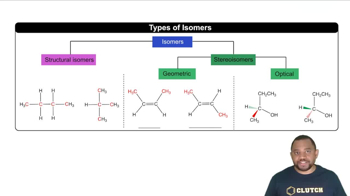Ch.23 - Transition Metals and Coordination Chemistry
Chapter 23, Problem 46
Complete the exercises below. Determine if each of the following metal complexes is chiral and therefore has an optical isomer: b. octahedral [Ni(en)(NH₃)₄]²⁺.
 Verified step by step guidance
Verified step by step guidance1
Step 1: Understand the structure of the complex. The complex [Ni(en)(NH₃)₄]²⁺ is an octahedral complex where 'en' stands for ethylenediamine, a bidentate ligand, and there are four ammonia (NH₃) ligands.
Step 2: Identify the coordination geometry. In an octahedral complex, the central metal ion is surrounded by six ligands at the vertices of an octahedron.
Step 3: Analyze the ligand arrangement. Ethylenediamine (en) is a bidentate ligand, meaning it forms two bonds with the central metal ion, occupying two adjacent coordination sites.
Step 4: Determine the potential for chirality. A complex is chiral if it cannot be superimposed on its mirror image. In octahedral complexes, chirality often arises when there is an asymmetric arrangement of ligands.
Step 5: Consider the symmetry of the complex. Since [Ni(en)(NH₃)₄]²⁺ has one bidentate ligand and four monodentate ligands, check if the arrangement of these ligands leads to a non-superimposable mirror image, indicating chirality.
Key Concepts
Here are the essential concepts you must grasp in order to answer the question correctly.
Chirality
Chirality refers to the geometric property of a molecule that makes it non-superimposable on its mirror image, much like left and right hands. A chiral molecule typically has an asymmetric carbon atom, but in coordination complexes, chirality can arise from the arrangement of ligands around a central metal atom. Understanding chirality is essential for determining whether a complex can exist in two enantiomeric forms.
Recommended video:
Guided course

Chirality
Octahedral Geometry
Octahedral geometry is a common arrangement in coordination chemistry where a central metal atom is surrounded by six ligands positioned at the corners of an octahedron. This geometry can lead to different spatial arrangements of the ligands, which can affect the chirality of the complex. In the case of [Ni(en)(NH₃)₄]²⁺, the arrangement of the ethylenediamine (en) and ammonia (NH₃) ligands is crucial for assessing its chirality.
Recommended video:
Guided course

Electron Geometry
Optical Isomers
Optical isomers, or enantiomers, are pairs of chiral molecules that are mirror images of each other and cannot be superimposed. These isomers have identical physical properties except for their interaction with plane-polarized light, where one will rotate the light in one direction and the other in the opposite direction. Identifying whether a metal complex has optical isomers is important in fields such as pharmaceuticals, where the activity of each enantiomer can differ significantly.
Recommended video:
Guided course

Types of Isomers
Related Practice
